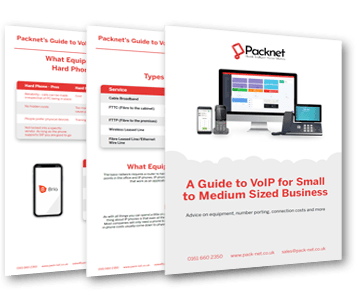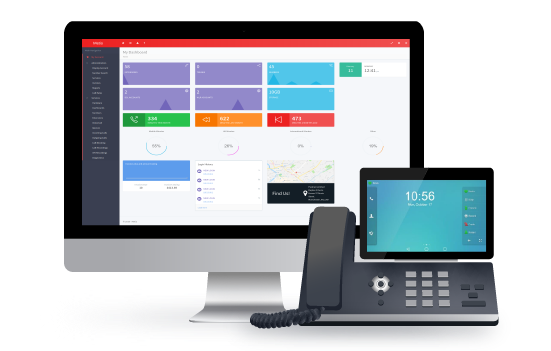Packnet’s guide to VoIP for business
I want to move my business to VoIP…
In choosing VoIP as your preferred telephony option the ITSP (Internet Telephony Service Provider) you choose to engage with will most likely discuss with you the majority of the topics listed below.
![]()
The things you will need to consider
Let’s start with the basics…
What is VoIP and how does it work?
VoIP or ‘Voice over Internet Protocol’ uses the internet to send phone calls. Your voice is converted to digital data and sent over the internet to the recipient in real time.

Is VoIP any different to traditional comms?
With VoIP you can call any landline or mobile number from a VoIP phone in the same way you would use a traditional analogue or digital phone and in turn anyone can call you.
The key points
1. How many people do you have in your business who use a telephone as part of their everyday job?
This will be the number that is used in various options as the multiplier. It will determine how many IP phones you need, how many ethernet points in your office, how many switches in your local area network. In this scenario we will take 10 as that number.
2. What level of internet connectivity do you have and will you need?
Connectivity comes in various sizes and costs. We have tried to put the various options available to you in order of costs based on the current UK market.
![]()
Types of connectivity
| Service | Speed |
|---|---|
| Cable Broadband | Up to 1Gbps |
| FTTC (Fibre to the cabinet) | (the future of current UK connectivity to the masses) – Up to 80Mb |
| FTTP (Fibre to the premises) | Up to 1Gbps |
| Wireless Leased Line | Up to 1Gbps |
| Fibre Leased Line/Ethernet Wire Line | Up to 1Gbps |
What equipment do you need?
The basic business VoIP network requires, a router to handle the internet connection, a switch to multiply the amount of end points and IP phones. IP phones can come as physical devices (hard phones) or software phones that work as an application on your PC/MAC/Laptop (soft phones).
![]()
IP phones
As with all things you can spend a little on phones… or a lot, so it’s best to know what your budget is. The good thing about IP phones is that even at the starting end of the scale the majority of functionality is available. Most companies will only need a phone to do the thing it was intended for – making phone calls. The increase in phone costs usually come down to physical features being added to the phone – larger displays, LED screens and more buttons.
Network equipment
When moving from traditional communications to hosted telephony or even if VoIP is your fist option, one thing to consider is that you are increasing the number of devices that will be connected to your local area network. In the model of a 10 user business let’s look at what will usually be in place.
PCs & laptops
Wired via ethernet cables and wireless (10 wired/wireless devices)
Printers
(1-2 devices)
Servers
This is decreasing with the advent of cloud based technologies but it still applies to a lot of businesses (1 device)
Phones
These if traditional will not take up space on your LAN at present but when moving to VoIP you will be adding 10 new IP devices to your network.
If we take it that each person will have two devices (PC or Laptop & Phone) and there is also one or two printers then we know that the following is required.
- 1 Router
- 1 Switch with at least 24 ports and preferably with POE
- 22 Ethernet Cat5/6 points around the office
- Power sockets for PCs and laptops. If POE is used on the switch then power sockets are not required for the phones.
Infrastructure notes
When building your infrastructure try to add devices that will last longest and reduce costs in other places. A good example of this is using Power Over Ethernet (POE) switches.
Most IP phones can now be powered via an ethernet cable connected to a POE Switch. This in turn can reduce the number of power points that you will need around your office.
Hard Phones
| Pros | Cons |
|---|---|
| Reliability – calls can be made irrespective of PC being in place | Cost |
| No hidden costs | Too many buttons can cause problems for users |
| People prefer physical devices | Training |
| Not locked into a specific vendor. As long as the phone supports SIP you are good to go |
Soft Phones
| Pros | Cons |
|---|---|
| Cost effective | Training |
| Easy deployment | |
| Software lasts longer than hardware | |
| Reduction in ethernet points required | |
| Takes up no desk space |
![]()
Number portability – can you keep your current numbers?
The short answer is yes. Moving numbers from one provider to another in the UK is called ‘number porting’. This process required your new ITSP to make a request to your current Telecoms provider to have the numbers repointed to their network. This is handled via Ofcom’s nominated third party which in the UK is the British Telecommunications porting desk. Numbers that can be ported between providers are geographic numbers (01, 02) and non-geographic (03, 08).
![]()
Points to know before porting your numbers
1. Who is your current provider?
2. How many numbers do you have and how are those numbers delivered?
![]()
Do you need to keep all the numbers that you have?
You may want to remove some of the numbers you have. Tell your new provider that some numbers can be removed from your account during the porting process. These numbers will then be returned to the national number pool or the provider will reuse them with another client.
What are the benefits of VoIP for any business, not just those in the SME market?
The world of telecommunications and how businesses engage with both their customers and internally is ever evolving. Having a telecoms platform that can keep you one step ahead of the game is becoming ever more critical. Here are some of the points that we hear on why a business wants to move to a VoIP/hosted telephony solution.
| Benefits | |
|---|---|
| Reduction in costs | VoIP is cheaper than traditional services both in calls and fixed monthly charges. |
| Free calls | A misconception is that VoIP means Skype and that everything is free. This is not the case, but you should always benefit from free calls within your business and within providers telecoms network. |
| Functionality | Hosted platforms have functionality that previously was either an expensive optional extra or a complicated setup. Good examples of this are Voicemail2Email or IVR (Interactive Voice Response) that are now standard features of VoIP/hosted telephony. |
| Business continuity | If the connection goes down or disaster strikes your calls are still being answered, and because our management interface is online you can make changes with near real-time effect. |
| Scalability | Traditional comms providers tied clients into long term fixed cost contracts that didn’t take into account the fluid nature of some businesses. With hosted you can scale up your users when times are busy or seasonal and scale back when you are not. |
| Management | Online access to management, and the ability to setup services in short times mean you can respond to the needs of your business and your customers. |
| Time | When it comes to delivering VoIP/hosted telecoms solutions then time becomes your friend. The time to set-up and have a VoIP solution running can be as little as 24/48 hours. A comparable traditional comms system using either analogue or digital lines can start at delivery within 7-10 days (analogue) and go right up to 60+ days (digital). |
| Geography | VoIP doesn’t care about location. As long as you have an internet connection you should be able to benefit from the advantages of VoIP. This makes VoIP ideal for home/remote/mobile workers. If you have a business with ten people in it based in an office or 10 people scattered across all the continents then VoIP joins you all together as one entity that can collectively benefit. |
![]()
Conclusion
VoIP is the solution that business is now looking to, to provide the communications infrastructure for the 21st century. Traditional communications platforms still have a place but they are becoming less relevant in today’s markets.
If VoIP/hosted telephony is not the solution you move to immediately it should be one your horizon. Your business should analyse what the demands will be upon it both now and in the near future. Once you have understood your needs, then chances are that VoIP/hosted telephony will give the best return on investment both in terms of infrastructure but more importantly efficiency and longevity.
Get in touch
For further information or to talk to us about the Packnet SME VoIP solution:


